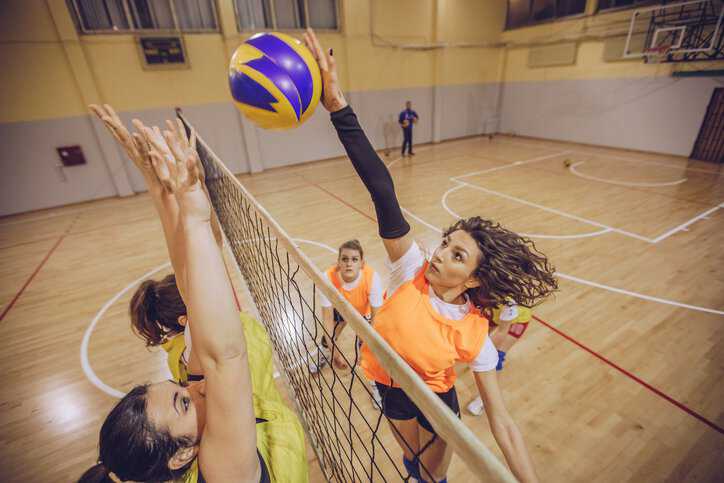ASTM F3683-24: Basketball and Volleyball Terminology

Basketball and volleyball each originated in Massachusetts in the late 19th century; both sports were created by pioneering physical directors. ASTM F3683-24: Standard Terminology Relating To Commercially Installed Basketball Equipment, Volleyball Equipment, Practice Cages And Divider Curtains For Indoor Public Venues specifies terminology for commercially installed indoor basketball equipment, volleyball equipment, practice cages, and divider curtains.
The Birth of Basketball and Volleyball
James Naismith, an 1891 graduate of Springfield College (then the International YMCA Training School) taught at the college for five years during which time he created the game of basketball. In the same vein, William G. Morgan, also a graduate of Springfield College, invented the game of volleyball in Holyoke, MA.
Morgan was influenced by his teacher James Naismith. He was inspired to invent a game that was less vigorous and physically demanding than basketball that the older members of the YMCA could play. Thus came the invention of volleyball. The game was fit for the gymnasium or exercise hall and could also be played outdoors.
What Is ASTM F3683?
ASTM F3683-24 covers definitions related to commercially installed basketball equipment, volleyball equipment, practice cages, and gymnasium divider curtains for use in public venues, such as gymnasium spaces in schools, health clubs, recreation centers, churches and similar facilities available for use by the general public. The terminology in this standard may also be used for home gyms or other private use facilities.
Basketball’s Influence on Volleyball
In 1895, William G. Morgan—an instructor at the Young Men’s Christian Association (YMCA)—decided to blend basketball, baseball, tennis, and handball. At the time he called volleyball “mintonette,” and the name was later changed as suggested by Springfield College teacher Alfred Halstead, who remarked to Morgan that the players seemed to be volleying the ball back and forth.
Volleyball allowed for the use of hands from handball, and it included innings (later to be called sets) borrowed from baseball. It also used a net from tennis; the first volleyball net was only 6’6″ high (the average American was shorter in the nineteenth century). For reference, today’s (indoor) volleyball nets are 7/12’’ for men and 7’4’’ high for women. Morgan’s game of volleyball would demand less physical contact than basketball, and it appealed to people who found basketball’s bumping or jolting too strenuous.
Rules of Volleyball
Under the original rules of volleyball, play began when a player served the ball over the net into the opponent’s court or field. The opponents then would not let the ball strike the floor but return it. This pattern was repeated back and forth until one side failed to return the ball to the other side, or the ball hit the floor. The side that served the ball would earn a point when the opposing side either failed to return the ball or allowed the ball to hit the floor.
Volleyball reached Japan and Asia via the YMCA network by 1896. Introduced in 1900, a new specifically designed ball came into existence, which opened up a new array of tactical and technical possibilities for the sport.
Over the next 20 years, technical rules for volleyball were established, refined, and standardized. The Philippines created the “set” and “spike” in 1916 (this was a new offensive way of playing the game that was called “bomba” or “Filipino bomb”); points per set changed from 21 to 15 points in 1917; and six-a-side play was the standard by 1918. In 1920, the rules mandating three hits per side and back-row attacks (when one of the three back row players attacks the ball and contacts it at the top of the net about three meters behind the 3-meter line) were instituted.
Volleyball at the Olympics
April 1947 saw the establishment of the Federation Internationale de Volleyball (FIVB). The international body included representatives from 14 nations: Belgium, Brazil, Czechoslovakia, Egypt, France, the Netherlands, Hungary, Italy, Poland, Portugal, Romania, Uruguay, the USA and Yugoslavia. The FIVB met in Paris to set up the association that would govern volleyball at the international level. With an international body to look after the sport and with its growing popularity, the International Olympic Committee (IOC) granted volleyball Olympic status in 1957, and volleyball made its Olympic debut at the Tokyo 1964 Games.
ASTM F3683-24: Standard Terminology Relating To Commercially Installed Basketball Equipment, Volleyball Equipment, Practice Cages And Divider Curtains For Indoor Public Venues is available on the ANSI Webstore.






